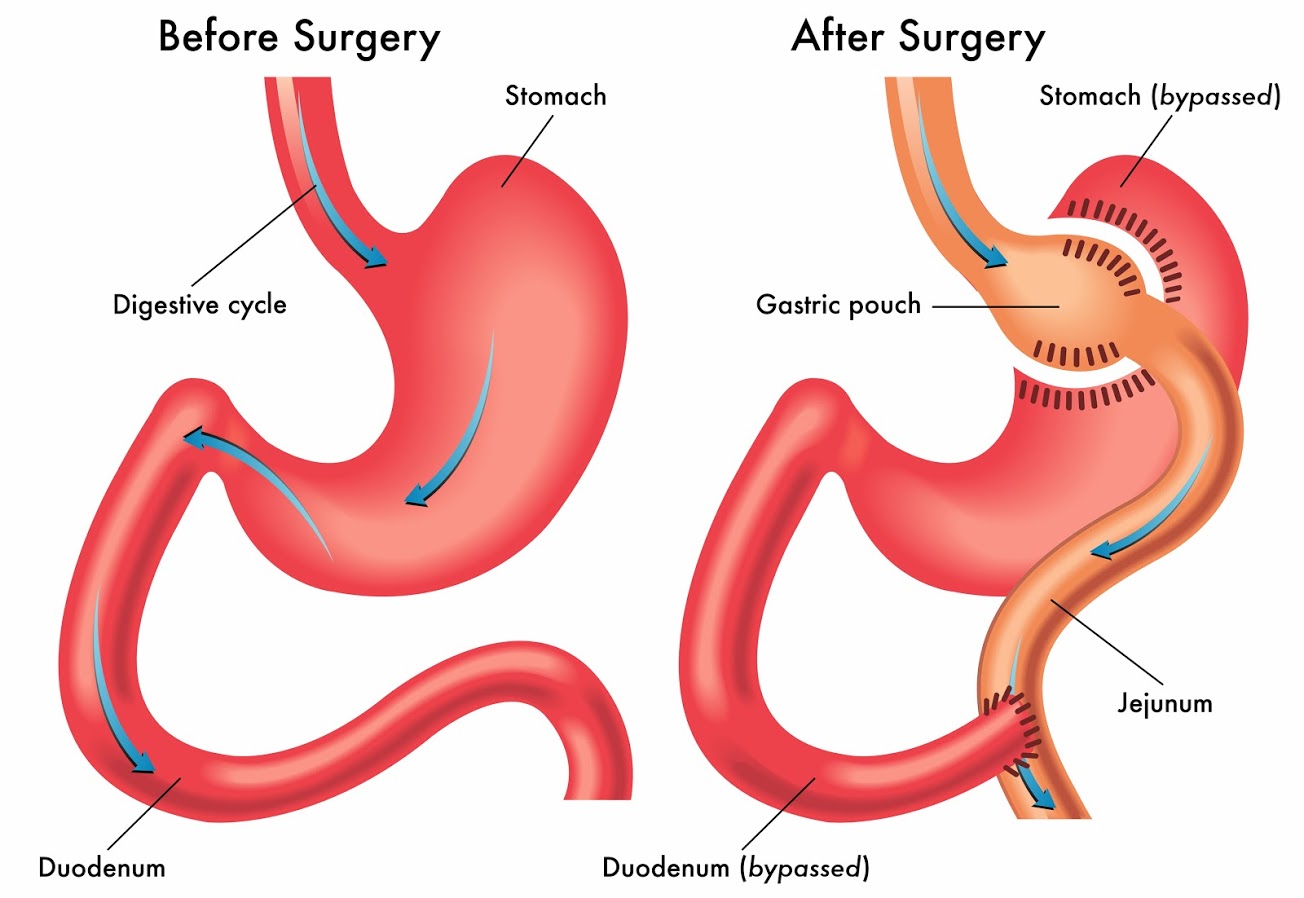What Is a Gastric Bypass?

Obesity is a life-threatening medical condition affecting over three million Americans every year. It can sometimes lead to other serious medical conditions, including type 2 diabetes, heart disease, fatty liver disease, obstructive sleep apnea and strokes. At The Center for Metabolic and Obesity Surgery in Maitland, FL, we are dedicated to improving the lives of each of our clients. In many cases, this involves a gastric bypass, also known as gastroplasty.
What Is a Gastric Bypass?
Gastric bypass surgery is a type of bariatric, or weight loss, procedure that alters your stomach and small intestine. These alterations change the way they absorb and digest food. Primarily, it helps clients lose weight by restricting the amount of food their stomachs can hold.
Secondarily, it limits the number of nutrients and calories their body can absorb. On a tertiary level, it alters their gut hormones. The result is a longer sensation of satiety, suppressing the appetite and reversing obesity-caused metabolic syndrome.
What Is Roux-en-Y Gastric Bypass?
Roux-en-Y gastric bypass is the most commonly performed bariatric procedure around the world. Considered the “gold standard” of bariatric procedures, it begins with reducing your stomach to the size of an egg.
The top portion of the stomach is separated from the remainder of the stomach. From there, the small intestine is divided. The bottom end of the altered small intestine is lifted and connected to the egg-sized top portion of the stomach pouch.
Finally, the top portion of the small intestine connects further down the small intestine. This allows your digestive enzymes and stomach acids which bypassed the bottom portion of your small intestine and stomach to mix with the food and beverages you consume.
Will My Health Insurance Provider Cover the Procedure?
Because obesity is one of the leading causes of death in America, most health insurance providers will cover your bariatric procedure, whether that is gastroplasty or an alternative. You will probably have your procedure and post-op prescriptions covered by your health insurance provider if you have a BMI greater than 40.
In some cases, your procedure will be covered if you have a BMI ranging from 35 to 39.9. However, you must also be diagnosed with a diabetes-related medical condition. Examples of such medical conditions include:
- High blood pressure
- Type 2 diabetes
- Sleep apnea
- Fatty liver disease
- Hyperlipidemia
Gastroplasty Diet
The gastroplasty diet is designed to give your stomach time to heal after your procedure without stretching it with excessive food. It also helps you grow accustomed to eating smaller portions that are comfortable and safe to digest given your new stomach size.
This diet will help you shed excess body weight quickly to mitigate your risk of obesity-related complications, and it helps to make your recovery process smooth.
What to Consume Throughout the Diet
Throughout each phase of the gastroplasty diet, you should drink at least half a gallon of fluid daily to avoid dehydration. You should sip beverages between your meals but not drink within 30 minutes of eating.
To avoid dumping syndrome, eat and drink slowly. Dumping syndrome occurs when food and drinks enter your small intestine too quickly and in volumes which are too large for your altered small intestine.
Every day, you should consume lean foods rich in protein. The foods and beverages you choose should be low in fats and sugar, and you should avoid alcohol for the first few months post-op. You should also limit caffeine as it is a diuretic and can lead to dehydration.
Take vitamin and mineral supplements as directed to ensure you do not suffer from any nutritional deficiencies. You must also chew all solid food until it has a pureed consistency before you swallow.
Liquid
For the first day or two post-op, you will only be able to consume clear liquids. Once you can handle these liquids well, you can slowly introduce other liquids into your diet. These include:
- Skim or 1% milk
- Decaffeinated tea and coffee
- Unsweetened juice
- Broth
- Sugar-free popsicles and gelatin
Pureed Foods
After approximately seven days on the liquid phase of your gastroplasty diet, you can start to introduce pureed and strained foods into your diet. These foods should have the consistency of a thick liquid or smooth paste. There should be no solid pieces of food in your meals.
During this portion of your diet, you should eat three to six small meals daily. Each meal should include no more than four to six tablespoons of food. It is very important that you eat slowly. Take approximately half an hour to complete each meal. Foods which puree well include:
- Cooked cereal
- Strained cream soups
- Soft fruits and cooked veggies
- Cottage cheese
- Soft scrambled eggs
- Lean fish, ground meat, ground poultry
You should blend your solid foods with liquids, such as water, skim milk, broth, or juice with no sugar added.
Soft Foods
A few weeks after following your pureed foods diet, ask us if you can start adding soft foods to your diet. These foods should be small, tender and chewed easily. At this point, you can eat between three and five small meals daily.
You can eat between one-third and one-half of a cup of food at each meal. Before you swallow, make sure you have chewed each bite to a pureed consistency. Here are some soft foods you can start to eat:
- Rice
- Dried or cooked cereal
- Cottage cheese
- Eggs
- Flaked fish
- Ground poultry or lean meat
- Canned or soft fresh fruit without skin or seeds
- Cooked veggies without skin
Solid Foods
After approximately eight weeks on the gastroplasty diet, you can start to eat firmer foods. At this point, you should be eating between one and one-and-a-half cups of food three times per day. However, you should stop eating before you feel full.
Talk to your dietitian about the ideal number of meals and portion sizes for your unique dietary needs. Introduce one new food or beverage into your diet at a time. Foods and drinks that may not be right for you during this stage of the gastroplasty diet include:
- Fried foods
- Nuts and seeds
- Popcorn
- Raw vegetables
- Carbonated drinks
- Breads
- Cooked fibrous vegetables
- Red meat
- Highly seasoned or spicy foods
- Tough or gristly meats
What Can I Expect After the Procedure?
For the first month post-op, you will only be able to consume small amounts of liquids and soft foods. For the next couple of months after that, you can slowly add solid foods back into your diet. The most important thing for you to be aware of is that you will feel full very quickly.
You will only be able to eat around two tablespoons of food at a time. You should take nutritional supplements to ensure you are getting all the nutrients your body needs despite your small portions.
What About Weight Loss?
Clients can expect to lose between half and two-thirds of their excess body weight within the first two years. After that, you can expect to lose weight at a reduced rate for another 18 months before your weight stabilizes.
For How Long Will I Be Out of Work?
You can go back to work as soon as you feel ready. Your entire recovery process may take between three and five weeks depending on the extent of the procedure and technique used. However, you should be able to go back to work within a week or two. The only exception to this is if you work in an environment where you need to remain completely alert at all times.
Keep in mind, you can return to a job requiring regular lifting within a couple of weeks of your procedure. Hernias post-op do not occur from excessively heavy lifting. They result from infections that will not occur if you take your antibiotics as prescribed.
What Is a Sleeve Gastrectomy?
A sleeve gastrectomy, also known as a gastric sleeve or vertical sleeve gastrectomy, is a bariatric procedure that is often recommended as an alternative to gastroplasty.
It is one of the most commonly performed bariatric procedures in the United States and results in weight loss of approximately 60% to 70% of excess body weight within one-year post-op. This is because between 75% and 80% of the stomach is removed. Here are a few benefits of this alternative to gastroplasty:
- Decreased desire to eat
- Reduction in hunger
- Remission or improvement of obesity-related diseases
What Can I Expect During a Sleeve Gastrectomy?
To perform a sleeve gastrectomy, your surgeon will make five small incisions in your abdominal wall to insert trocars. Once the stomach is inspected, the blood vessels to the lateral side stomach will be divided. From there, a Bougie tube is inserted into the stomach. This serves as a sizer for the new stomach.
A stapler is used to divide the stomach into two parts. Once the stomach is divided completely, you will be left with a banana-shaped stomach which holds only 20% to 25% of the volume of your original stomach.
How Much Weight Can I Lose With a Sleeve Gastrectomy?
The average client will lose between 60% and 70% of their excess body weight after a sleeve gastrectomy. During the first two weeks post-op, you can expect to lose between 10 and 20 pounds.
On average, clients lose approximately one pound per day. After the first three months post-op, between 35% and 45% of excess weight is lost. Within six months post-op, you can expect to have lost between 50% and 60% of your excess body weight.
After only a year post-op, you will have lost between 60% and 70% of your excess body weight. While clients who receive gastroplasty typically lose their excess body weight over the course of 40 months, clients who receive a sleeve gastrectomy typically reach their lowest weight within one to two years post-op.
Am I a Good Candidate for This Procedure?
You may be a good candidate for this procedure if you are looking for short-term and long-term weight loss. In the short term, this procedure can result in 60% to 80% of excess body fat loss.
According to 20-year studies, this procedure helps clients maintain over half of their excess weight loss. Even the initial results of the procedure can resolve obesity-related health problems.
Say No to Obesity Today
Are you ready to say “no” to obesity? If you are, contact the bariatric experts at The Center for Metabolic and Obesity Surgery in Maitland, FL today to schedule your initial consultation. Our experts will help you find the safest, most effective solution to end your obesity, whether that is a gastric bypass or another bariatric procedure. We can’t wait to meet you and help you get your life, and health, back on track.
- When Do You Stop Losing Weight After Gastric Bypass?
- Is Intermittent Fasting Safe After Weight Loss Surgery?
- Is Losing Weight Your #1 New Year’s Resolution? Find out How Weight Loss Surgery Can Help You Take It off and Keep It Off
- The Tie Between Weight Gain and the COVID-19 Pandemic
- When it Comes to Weight Loss Surgery, is Cheaper Always Better?

Are You a Candidate for Weight Loss Surgery?
Take our 60 second assessment and find out if you are a candidate for weight loss surgery


